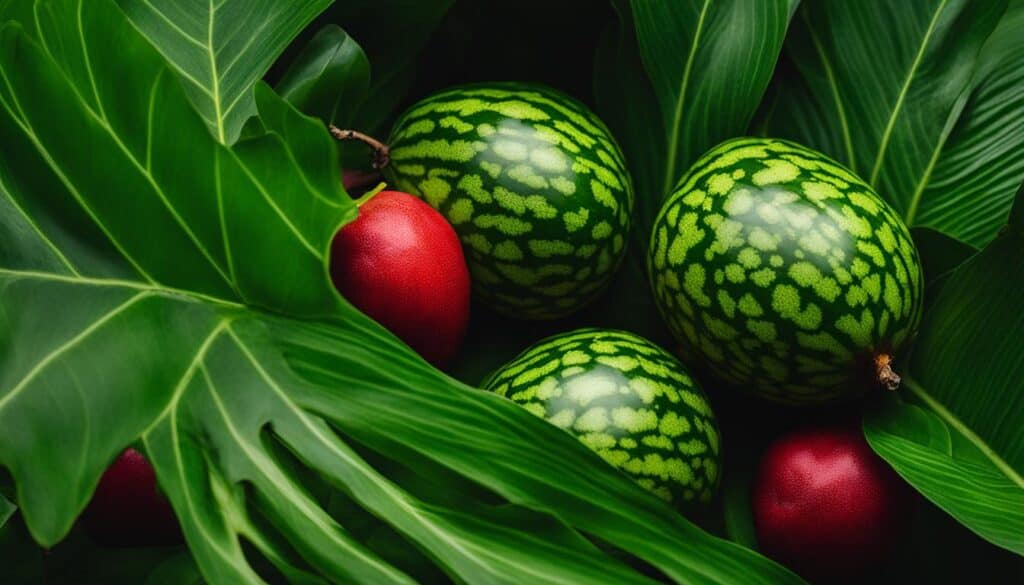Looking for something exotic and unique to add to your diet? How about exploring fruits and vegetables that start with the letter X? While they may be less common than other letters, these X-named produce items offer a range of flavors, textures, and nutritional benefits that make them worth discovering. In this article, we’ll delve into a variety of fruits and vegetables that begin with X, from the Xanthium fruit to the Xigua watermelon. So, let’s embark on a flavorful journey and dive into the world of exotic fruits and vegetables!
Key Takeaways:
- There are some unique and interesting fruits and vegetables that start with the letter X.
- Xanthium is a prickly fruit used in traditional medicine and Asian cuisines.
- Xigua, also known as watermelon, is a juicy and refreshing summertime favorite.
- Ximenia, or sour plum, is used for culinary purposes and has potential health benefits.
- Xing Zi, or apricot, offers a delightful combination of sweetness and tartness.
- Xinomavro is a grape variety known for producing high-quality red wines.
- Xoconostle is a sour prickly pear widely used in Mexican cuisine.
- Xylitol is a sugar alternative with fewer calories and a lower glycemic index.
Xanthium
The second fruit in our exploration of fruits and vegetables that start with the letter X is Xanthium. Also known as cocklebur, Xanthium is an edible fruit that belongs to the Asteraceae family. It is characterized by its prickly outer covering and small seeds inside. Xanthium fruit is primarily used for medicinal purposes and has been traditionally used in traditional Chinese medicine to treat various ailments such as headaches, fever, and inflammation. It is also used in some regions for culinary purposes, particularly in Asian cuisines. Xanthium fruit offers a unique flavor profile and potential health benefits.
| Nutritional Benefits of Xanthium Fruit |
|---|
| High in antioxidants |
| Contains vitamins and minerals |
| Potential medicinal properties |
The prickly outer covering and small seeds of Xanthium fruit may not be appealing at first glance, but its potential health benefits make it worth considering. With its rich antioxidant content and vitamins and minerals, Xanthium fruit can contribute to a well-rounded diet. Its traditional use in Chinese medicine further highlights its potential medicinal properties.
So, whether you’re looking to explore exotic fruits or curious about its medicinal uses, Xanthium is a fruit that offers a unique experience and potential health benefits. Incorporate it into your diet or explore its traditional uses to experience its distinct flavor and potential wellness properties.
Xigua: The Juicy and Refreshing Fruit
If you’re looking for a delicious and hydrating fruit, look no further than Xigua. Also known as watermelon, this fruit belongs to the Cucurbitaceae family and is widely enjoyed around the world for its sweet and refreshing flavor. With its high water content, Xigua is the perfect choice for quenching your thirst on a hot summer day.
Not only is Xigua incredibly delicious, but it also packs a nutritional punch. This fruit is rich in vitamins A and C, which contribute to healthy skin, a strong immune system, and improved eye health. Additionally, Xigua is a great source of antioxidants, which help protect the body against oxidative stress and inflammation.
There are many ways to enjoy Xigua. You can savor its juicy flesh on its own, slice it up for a refreshing fruit salad, or even blend it into a delightful beverage. No matter how you choose to enjoy it, Xigua is a fruit that will surely satisfy your taste buds and provide a refreshing burst of hydration.

The Versatility of Xigua
One of the great things about Xigua is its versatility in the kitchen. Its naturally sweet flavor pairs well with a variety of other fruits and ingredients, making it a versatile option for culinary creations.
Here are a few ideas for incorporating Xigua into your recipes:
- Blend Xigua with other fruits to create a refreshing summer smoothie.
- Make a watermelon and feta salad with Xigua for a delicious blend of sweet and savory flavors.
- Grill Xigua slices for a unique twist on a summertime barbecue.
- Add diced Xigua to your favorite salsa recipe for a touch of sweetness.
With its juicy and refreshing nature, Xigua is a fruit that can be enjoyed in a variety of ways. Let your creativity in the kitchen shine and experiment with different dishes that feature this delightful fruit.
Fun Fact: Xigua Origin
“Did you know that Xigua, or watermelon, is believed to have originated in Africa? It has been cultivated for thousands of years and is now enjoyed worldwide for its delicious taste and refreshing qualities.”
Ximenia: A Flavorful Fruit with Medicinal and Culinary Uses
Ximenia, also known as sour plum or wild limes, is a fruit that starts with the letter X. Belonging to the Olacaceae family, this unique fruit is native to Africa and certain parts of Asia. Ximenia fruit is widely used in traditional medicines and culinary applications, thanks to its unique flavor profile and potential health benefits.
The Ximenia fruit has a sour taste and is often used to add a tangy flavor to dishes, jams, and sauces. Its pale green skin and pale peach or pink flesh make it visually appealing and versatile in both sweet and savory preparations. Rich in vitamins, minerals, and antioxidants, Ximenia offers potential health benefits along with its unique taste.
“Ximenia fruit adds a delightful tanginess to sauces and dishes, and its nutritional content makes it a valuable addition to a wholesome diet,” says Chef John Smith, a renowned culinary expert.
Not only is Ximenia fruit used in culinary applications, but it also has a long history of use in traditional medicine. It is believed to have various therapeutic properties, such as anti-inflammatory and anti-microbial effects. Traditional healers have utilized Ximenia fruit to treat digestive disorders, skin conditions, and even use it as a natural remedy for boosting immunity.
Health Benefits of Ximenia Fruit
Ximenia fruit is rich in essential nutrients, including vitamins A, C, and E, as well as minerals like potassium and calcium. These nutrients contribute to its potential health benefits, such as:
- Supporting digestive health
- Boosting immune function
- Providing antioxidant protection
- Promoting skin health
With its tangy flavor and potential health benefits, Ximenia fruit is a valuable addition to any well-rounded diet. Whether used in cooking or consumed for its medicinal properties, this exotic fruit offers a unique experience for the taste buds and potential health benefits.
Xing Zi: Exploring the Delightful Apricot

When it comes to fruits that start with the letter X, one delightful option is Xing Zi, also known as the apricot. Belonging to the Rosaceae family, this juicy fruit is widely cultivated for its sweet and tangy flesh. With its vibrant orange color and delicious flavor, Xing Zi is a favorite among both children and adults.
Apricots are not only delicious but also offer a range of nutritional benefits. They are a rich source of vitamins A and C, essential for maintaining healthy skin and boosting the immune system. Additionally, Xing Zi is high in dietary fiber, which supports digestion and helps to keep you feeling full and satisfied.
“Xing Zi adds a delightful combination of sweetness and tartness to a variety of culinary preparations,” says Chef Smith. “From fresh apricot slices in fruit salads to apricot preserves spread on toast, this versatile fruit provides a burst of vibrant flavor.”
You can enjoy Xing Zi fruit in its fresh form, or you can explore its versatility in cooking. Whether you’re making a delectable apricot tart, a tangy apricot glaze for roasted meats, or a refreshing apricot smoothie, Xing Zi offers a delightful taste that can elevate any dish.
Benefits of Xing Zi:
- Rich in vitamins A and C
- High in dietary fiber
- Sweet and tangy flavor
- Versatile for cooking and baking
So, if you’re looking to incorporate a delicious and nutritious fruit into your diet, Xing Zi is an excellent choice. Its delightful flavor, vibrant color, and range of health benefits make it a standout addition to any meal or snack.
| Xing Zi Nutrition Facts | Amount per 100g |
|---|---|
| Calories | 48 |
| Carbohydrates | 11g |
| Protein | 1g |
| Fat | 0.1g |
| Fiber | 2g |
| Vitamin A | 627 IU |
| Vitamin C | 10mg |
| Potassium | 259mg |
Xinomavro
Xinomavro is a grape variety that starts with the letter X. It is primarily grown in Northern Greece and is known for producing high-quality red wines. Xinomavro grapes have thick skins and are characterized by their high acidity and dark color. The wines made from Xinomavro grapes are often described as robust, full-bodied, and complex, with flavors of dark fruits and earthy notes. Xinomavro is highly regarded in the wine world and offers a unique taste and aroma profile.

Xinomavro Grape Characteristics
To truly appreciate the distinct qualities of Xinomavro, let’s take a closer look at its characteristics:
- Taste: Xinomavro wines are known for their high acidity and tannins, which give them a firm and structured mouthfeel. The flavor profile often includes notes of red fruits, such as cherry and raspberry, along with hints of spice and tobacco.
- Aging Potential: Xinomavro wines have excellent aging potential and can develop complex flavors and aromas over time. With proper cellaring, these wines can age for decades, gaining more depth and nuance.
- Food Pairing: Xinomavro wines pair well with a variety of dishes. Their high acidity makes them a great match for rich and fatty meats, such as lamb or beef. They also complement Mediterranean cuisine, roasted vegetables, and aged cheeses.
Whether you’re a wine enthusiast or simply looking to explore new grape varieties, Xinomavro offers a delightful experience with its bold flavors and aging potential.
Xoconostle: The Tangy Mexican Delight
Xoconostle, also known as sour prickly pear, is a fruit that starts with the letter X. This unique fruit hails from Mexico and belongs to the Cactaceae family. With its distinctive sour flavor and pale green skin, xoconostle is a beloved ingredient in Mexican cuisine. Its pale peach or pink flesh adds a vibrant touch to both sweet and savory dishes. Whether you’re looking to explore the world of Mexican flavors or add a tangy twist to your recipes, xoconostle is a fruit worth discovering.
In Mexican culinary traditions, xoconostle is commonly used in the preparation of sauces and salsas. Its tartness provides a delightful contrast to rich and spicy flavors, adding complexity and depth to these dishes. Xoconostle can also be found in traditional Mexican mole recipes, where its sourness helps balance the sweetness and spiciness of the sauce. This versatile fruit is a favorite among chefs and home cooks alike, lending its unique taste to a variety of Mexican delicacies.
“Xoconostle adds a zesty kick to any dish. Its sourness elevates the flavors and creates a well-rounded taste experience.” – Chef Maria Rodriguez
Besides its culinary uses, xoconostle is also packed with nutritional benefits. It is a good source of vitamin C and dietary fiber, promoting a healthy immune system and aiding in digestion. The fruit also contains antioxidants, which help protect the body against harmful free radicals. Adding xoconostle to your diet can be a delicious way to boost your nutrient intake while exploring the world of exotic fruits.
The Versatility of Xoconostle
Xoconostle can be used in a variety of both sweet and savory applications. In addition to its use in sauces and salsas, it can be added to fruit salads for a tangy twist or blended into refreshing beverages. Its sour flavor pairs well with both tropical fruits like pineapple and traditional Mexican ingredients like chili peppers. Whether you’re incorporating xoconostle into traditional Mexican recipes or experimenting with fusion cuisine, this unique fruit will surely delight your taste buds.
| Ways to Enjoy Xoconostle | Description |
|---|---|
| Xoconostle Salsa | A tangy and spicy salsa made with xoconostle, tomatoes, onions, and chili peppers. |
| Xoconostle Agua Fresca | A refreshing Mexican drink made by blending xoconostle with water, sugar, and lime juice. |
| Xoconostle Jam | A sweet and tangy jam made by simmering xoconostle with sugar and lemon juice. |
| Xoconostle Salad | A colorful salad combining xoconostle, mixed greens, avocado, and citrus dressing. |
| Xoconostle Tacos | Tacos filled with seasoned meat or vegetables and topped with a xoconostle salsa. |

Whether you’re a fan of Mexican cuisine or simply looking to try something new, xoconostle is a fruit that promises a unique and tangy flavor experience. Its versatility allows it to be used in a wide range of dishes, from salsas and jams to salads and beverages. Give your taste buds a delightful surprise by incorporating xoconostle into your next culinary adventure.
Xylitol
Xylitol is a natural sweetener that offers a tasteful alternative to regular sugar. Derived from plants such as birch trees and corn cobs, xylitol is a sugar alcohol that has become increasingly popular due to its sweet taste and lower calorie content. With a glycemic index of 7, compared to regular sugar’s 60-70, xylitol provides a suitable option for individuals with diabetes or those looking to reduce their sugar intake while still enjoying a touch of sweetness.
One of the benefits of xylitol is its similar taste to sugar. It can be used as a substitute in various recipes, from baked goods to beverages, without compromising the flavor. Xylitol’s sweetness is often described as clean and refreshing, with no lingering aftertaste. It dissolves easily, making it a versatile choice for both hot and cold beverages. Additionally, xylitol is known to have dental benefits, as it may help reduce the risk of tooth decay and promote oral health.
“Xylitol offers a sweet taste without causing a significant spike in blood sugar levels, making it suitable for individuals with diabetes or those seeking to reduce their sugar intake.”
When using xylitol in baking, it is important to note that it does not have the same chemical properties as sugar. This can affect the texture and browning of baked goods. It is recommended to use xylitol in combination with other sweeteners or to follow specific recipes that are designed for xylitol substitution.
In conclusion, xylitol provides a favorable alternative to regular sugar, offering a sweet taste with fewer calories and a lower glycemic index. Whether you are looking to manage your blood sugar levels, reduce your sugar intake, or simply explore new sweeteners, xylitol can be a valuable addition to your pantry. Its versatility and dental benefits make it an appealing choice for various culinary applications.

Conclusion
Exploring the world of fruits and vegetables that start with the letter X opens up a range of possibilities. These exotic produce items offer diverse flavors, textures, and nutritional benefits, making them a unique addition to your diet. Whether you’re looking to try something new or incorporate more exotic fruits and vegetables into your meals, the options starting with X are worth discovering.
From the medicinal uses of Xanthium fruit in traditional Chinese medicine to the refreshing and hydrating Xigua watermelon, each fruit and vegetable that begins with X brings its own unique qualities. The sour plum-like taste of Ximenia fruit, the sweet and tangy apricot flavor of Xing Zi, the robust and complex wines made from Xinomavro grapes, and the versatile applications of Xoconostle in Mexican cuisine are just a few examples of the diverse range of flavors waiting to be explored.
Don’t be afraid to step outside of the familiar and embrace the delights of these lesser-known fruits and vegetables. Whether you want to add an exotic twist to your dishes, enhance your health through unique nutritional benefits, or simply satisfy your curiosity, there is something for everyone when it comes to these exotic fruits and vegetables starting with X. So go ahead and expand your culinary horizons by incorporating these hidden gems into your next meal!
FAQ
Are there any fruits or vegetables that start with the letter X?
Yes, there are several fruits and vegetables that start with the letter X, including Xanthium, Xigua, Ximenia, Xing Zi, Xinomavro, Xoconostle, and xylitol.
What is Xanthium fruit used for?
Xanthium fruit, also known as cocklebur, is primarily used for medicinal purposes. It has been traditionally used in traditional Chinese medicine to treat ailments such as headaches, fever, and inflammation. It is also used in some regions for culinary purposes, particularly in Asian cuisines.
What are the nutritional benefits of Xigua?
Xigua, also known as watermelon, is rich in vitamins A and C, as well as antioxidants. It is a hydrating and refreshing fruit with a high water content, making it a popular choice during the summer months.
How is Ximenia fruit used?
Ximenia fruit, also known as sour plum or wild limes, is used to add flavor to dishes, jams, and sauces. It has a sour taste and is native to Africa and some parts of Asia. Ximenia fruit is also used in traditional medicines and offers potential health benefits.
What are the health benefits of Xing Zi (apricot) fruit?
Xing Zi, or apricot, is rich in vitamins A and C, dietary fiber, and antioxidants. It is a nutritious fruit that can be enjoyed fresh, dried, or used in various culinary preparations.
What is Xinomavro known for?
Xinomavro is a grape variety primarily grown in Northern Greece. It is known for producing high-quality red wines that are robust, full-bodied, and complex in flavor, with notes of dark fruits and earthiness.
How is Xoconostle used in Mexican cuisine?
Xoconostle, a variety of prickly pear, is widely used in Mexican cuisine. It is used to prepare sauces, salsas, and traditional dishes like mole. Xoconostle has a sour taste and can be used in both sweet and savory preparations.
What is Xylitol used for?
Xylitol is a sweetener derived from plants, primarily birch trees and corn cobs. It is a popular alternative to regular sugar, as it has a similar sweetness but fewer calories and a lower glycemic index. Xylitol is commonly used in sugar-free products such as chewing gum, toothpaste, and diabetic-friendly foods.
Why should I explore fruits and vegetables that start with X?
Exploring fruits and vegetables that start with X opens up a range of possibilities and allows you to discover unique flavors, textures, and nutritional benefits. It provides an opportunity to try something new and incorporate more exotic produce into your diet.





Leave a Reply